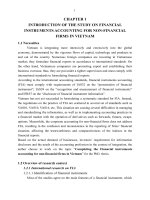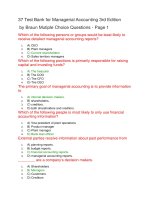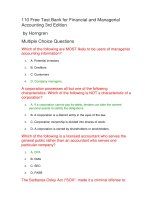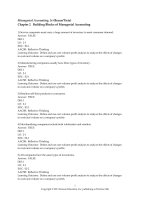Financial managerial accounting 3rd kieso ch01(accounting in action)
Bạn đang xem bản rút gọn của tài liệu. Xem và tải ngay bản đầy đủ của tài liệu tại đây (3.91 MB, 75 trang )
Financial &
Managerial
Accounting
3rd Edition
Jerry Weygandt, Paul
Kimmel, Don Kieso
Prepared by
Coby Harmon
University of California, Santa
Barbara
Westmont College
1-1
1
Accounting in Action
Learning Objectives
1-2
1
Identify the activities and users associated with accounting.
2
Explain the building blocks of accounting: ethics, principles,
and assumptions.
3
State the accounting equation, and define its components.
4
Analyze the effects of business transactions on the accounting
equation.
5
Describe the four financial statements and how they are
prepared.
LEARNING
OBJECTIVE
1
Identify the activities and users
associated with accounting.
Accounting consists of three basic activities—it
identifies,
records, and
communicates
the economic events of an organization to interested users.
1-3
LO 1
Three Activities
Illustration 1-1
The activities of the accounting process
The accounting process includes
the bookkeeping function.
1-4
LO 1
Who Uses Accounting Data
INTERNAL
USERS
Illustration 1-2
Questions that internal
users ask
1-5
LO 1
1-6
LO 1
Who Uses Accounting Data
EXTERNAL
USERS
1-7
Illustration 1-3
Questions that external
users ask
LO 1
1
Basic Concepts
Indicate whether the following statements are true or false.
1. The three steps in the accounting process are identification,
recording, and communication.
2. Bookkeeping encompasses all steps in the accounting process.
3. Accountants prepare, but do not interpret, financial reports.
4. The two most common types of external users are investors and
company officers.
5. Managerial accounting activities focus on reports for internal users.
Solution: 1. True
2. 3. 4. False
5.
1-8
False
False
True
LO 1
LEARNING
OBJECTIVE
2
Explain the building blocks of accounting:
ethics, principles, and assumptions.
Ethics in Financial Reporting
Recent financial scandals include: Enron, WorldCom,
HealthSouth, AIG, and other companies.
Regulators and lawmakers concerned that economy would
suffer if investors lost confidence in corporate accounting. In
response,
►
1-9
Congress passed Sarbanes-Oxley Act (SOX).
Effective financial reporting depends on sound ethical
behavior.
LO 2
Ethics in Financial Reporting
Illustration 1-4
Steps in analyzing ethics cases
and situations
1-10
LO 2
Ethics in Financial Reporting
Question
Ethics are the standards of conduct by which one's actions
are judged as:
a. right or wrong.
b. honest or dishonest.
c. fair or not fair.
d. all of these options.
1-11
LO 2
1-12
LO 2
Generally Accepted Accounting Principles
Various users
need financial
information
Financial Statements
The accounting profession
has developed standards
that are generally accepted
and universally practiced.
1-13
Balance
Balance Sheet
Sheet
Income
Income Statement
Statement
Statement
Statement of
of Stockholders’
Stockholders’ Equity
Equity
Statement
Statement of
of Cash
Cash Flows
Flows
Note
Note Disclosure
Disclosure
Generally Accepted
Accounting
Principles (GAAP)
LO 2
Generally Accepted Accounting Principles
Generally Accepted Accounting Principles (GAAP) – Standards
that are generally accepted and universally practiced. These
standards indicate how to report economic events.
Standard-setting bodies:
1-14
►
Financial Accounting Standards
Board (FASB)
►
Securities and Exchange
Commission (SEC)
►
International Accounting Standards
Board (IASB)
LO 2
1-15
LO 2
Measurement Principles
HISTORICAL COST PRINCIPLE (or cost principle) dictates
that companies record assets at their cost.
FAIR VALUE PRINCIPLE states that assets and liabilities
should be reported at fair value (the price received to sell an asset
or settle a liability).
Selection of which principle to follow
generally relates to trade-offs
between relevance and faithful
representation.
1-16
LO 2
Assumptions
MONETARY UNIT ASSUMPTION requires that companies
include in the accounting records only transaction data that can
be expressed in terms of money.
ECONOMIC ENTITY ASSUMPTION requires that activities of
the entity be kept separate and distinct from the activities of its
owner and all other economic entities.
1-17
Proprietorship
Partnership
Corporation
Forms of Business
Ownership
LO 2
Forms of Business Ownership
Proprietorship
Owned by one
person
Owned by two or
more persons
Owner is often
manager/operator
Often retail and
service-type
businesses
1-18
Partnership
Owner receives
any profits, suffers
any losses, and is
personally liable
for all debts
Generally
unlimited
personal liability
Corporation
Ownership
divided into
shares of stock
Separate legal
entity organized
under state
corporation law
Limited liability
Partnership
agreement
LO 2
Assumptions
Question
Combining the activities of Kellogg and General Mills
would violate the
a. cost principle.
b. economic entity assumption.
c. monetary unit assumption.
d. ethics principle.
1-19
LO 2
Assumptions
Question
A business organized as a separate legal entity under state
law having ownership divided into shares of stock is a
a. proprietorship.
b. partnership.
c. corporation.
d. sole proprietorship.
1-20
LO 2
1-21
2
Building Blocks of Accounting
Indicate whether each of the following statements presented
below is true or false.
1-22
1.
Congress passed the Sarbanes-Oxley Act to reduce
unethical behavior and decrease the likelihood of
future corporate scandals.
True
2.
The primary accounting standard-setting body in the
United States is the Financial Accounting Standards
Board (FASB).
True
3.
The historical cost principle dictates that companies
record assets at their cost. In later periods, however,
the fair value of the asset must be used if fair value
is higher than its cost.
False
LO 2
2
Building Blocks of Accounting
Indicate whether each of the following statements presented
below is true or false.
1-23
4.
Relevance means that financial information matches
what really happened; the information is factual.
False
5.
A business owner ’ s personal expenses must be
separated from expenses of the business to comply
with accounting’ s economic entity assumption.
True
LO 2
LEARNING
OBJECTIVE
3
Assets
State the accounting equation, and define
its components.
=
Liabilities
+
Stockholder’s
Equity
Basic Accounting Equation
1-24
Provides the underlying framework for recording and
summarizing economic events.
Assets must equal the sum of liabilities and stockholders’
equity.
If a business is liquidated, claims of creditors (liabilities)
must be paid before ownership claims (stockholders’ equity).
LO 3
Basic Accounting Equation
Assets
=
Liabilities
+
Stockholder’s
Equity
Assets
1-25
Resources a business owns.
Provide future services or benefits.
Cash, Supplies, Equipment, etc.
LO 3









